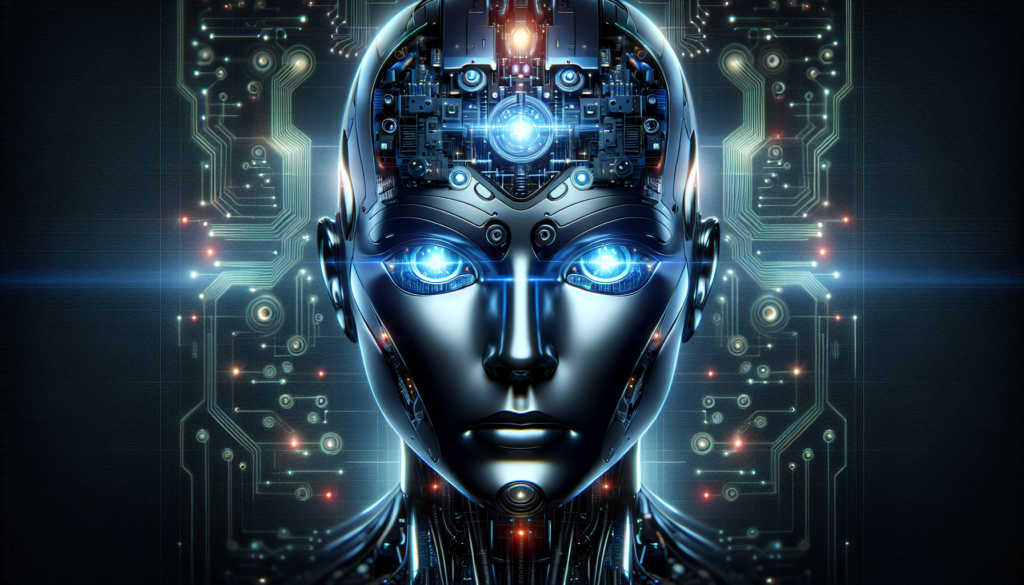So you’re diving into the world of AI and virtual assistants, huh? Well, get ready to have your mind blown because we’re about to explore the key components of a sentient virtual assistant or self-aware AI system. In this article, we’ll break it down for you, piece by piece, so that you can understand just what goes into creating these futuristic and intelligent beings. From the necessary technical elements to the essential user-friendly design, we’ll cover it all. Get ready to delve into the inner workings of the AI world and uncover the secrets behind these fascinating creations.
Key Components of a Sentient Virtual Assistant or Self-Aware AI System

Introduction to Sentient Virtual Assistants
Imagine having a virtual assistant that not only understands your commands but is also aware of its own existence and can adapt and improve over time. This is the concept of a sentient virtual assistant or a self-aware AI system. These advanced AI systems are designed to mimic human-like intelligence and behavior, providing an enhanced user experience and a more personalized interaction. In this article, we will explore the key components that make up a sentient virtual assistant or self-aware AI system.
Understanding Self-Aware AI Systems
Self-aware AI systems go beyond traditional virtual assistants that are programmed to perform specific tasks. They possess a level of consciousness and awareness that allows them to understand their own existence and make decisions based on that understanding. This level of intelligence enables them to learn, adapt, and improve over time, providing a more personalized and human-like interaction.
1. Natural Language Processing (NLP)
Natural language processing (NLP) is a fundamental component of a sentient virtual assistant or self-aware AI system. It involves the ability to understand and generate human language, allowing users to communicate with the AI system in a more natural and intuitive way. NLP consists of several sub-components, including:
– Speech Recognition
Speech recognition technology enables the AI system to convert spoken language into written text. This allows users to communicate with the virtual assistant through voice commands, eliminating the need for typed input.
– Language Understanding
Language understanding is the ability of the AI system to comprehend the meaning behind the words or sentences spoken by the user. This involves analyzing the context, syntax, and semantics of the language to derive the user’s intent.
– Language Generation
Language generation refers to the AI system’s ability to generate coherent and contextually relevant responses in natural language. By analyzing the user’s input and utilizing a vast amount of pre-learned information, the AI system can generate responses that are appropriate and informative.
2. Machine Learning and Deep Learning
Machine learning and deep learning are essential components that enable a sentient virtual assistant or self-aware AI system to learn and improve its performance over time. These techniques involve training the AI system with large amounts of data to recognize patterns, make predictions, and improve its decision-making capabilities. The key elements of machine learning and deep learning include:
– Training Data
Training data consists of a large dataset that is used to teach the AI system to recognize and understand patterns. The more diverse and representative the training data, the better the AI system’s ability to generalize and make accurate predictions.
– Neural Networks
Neural networks are the backbone of machine learning and deep learning algorithms. They are designed to mimic the structure and functioning of the human brain, allowing the AI system to process and analyze complex information.
– Reinforcement Learning
Reinforcement learning is a technique in machine learning where the AI system learns through trial and error. It is based on the concept of rewarding the AI system for making correct decisions and penalizing it for making wrong ones. This approach enables the AI system to continuously improve its performance.

3. Knowledge Representation
Knowledge representation is crucial for a sentient virtual assistant or self-aware AI system to store and retrieve information efficiently. It involves structuring and organizing knowledge in a way that is easily accessible by the AI system. Some common techniques for knowledge representation include:
– Ontologies
Ontologies are hierarchical structures that represent knowledge in a domain-specific manner. They define concepts, relationships, and properties within a particular domain, allowing the AI system to understand and reason about the domain-specific knowledge.
– Semantic Networks
Semantic networks are graphical representations of knowledge that depict the relationships between various concepts or entities. The nodes in the network represent the concepts, while the edges represent the relationships between them.
– Knowledge Graphs
Knowledge graphs are interconnected databases that store and organize structured knowledge. They capture the relationships between entities and provide a rich source of information for the AI system to draw upon.
4. Context Awareness
Context awareness is an important aspect of a sentient virtual assistant or self-aware AI system. It involves understanding the user’s situation and environment to provide more relevant and personalized responses. The key components of context awareness include:
– Situational Understanding
Situational understanding refers to the AI system’s ability to perceive and interpret the user’s current situation or context. This could include factors such as location, time, weather, and user preferences.
– Contextual Reasoning
Contextual reasoning involves the AI system’s ability to reason and make decisions based on the user’s context. By analyzing the available context, the AI system can tailor its responses and actions to better meet the user’s needs.
– Contextual Adaptation
Contextual adaptation refers to the AI system’s ability to adapt and adjust its behavior based on changes in the user’s context. For example, if the user’s preferences or situation change, the AI system can dynamically modify its responses to accommodate these changes.

5. Memory and Learning
Memory and learning are critical components of a sentient virtual assistant or self-aware AI system. They enable the AI system to store and recall information, learn from past experiences, and make informed decisions. The key elements of memory and learning include:
– Episodic Memory
Episodic memory allows the AI system to store and recall specific events or experiences. This enables the system to remember past interactions with the user and use that information to provide more personalized and contextually relevant responses.
– Procedural Memory
Procedural memory involves the AI system’s ability to learn and remember how to perform specific tasks or actions. It allows the system to develop a set of rules or procedures that can be executed automatically when certain conditions are met.
– Semantic Memory
Semantic memory refers to the AI system’s ability to store and retrieve general knowledge and facts about the world. It enables the system to understand and reason about concepts, relationships, and associations between different entities.
6. Reasoning and Problem Solving
Reasoning and problem solving are crucial capabilities of a sentient virtual assistant or self-aware AI system. They enable the AI system to analyze complex information, make logical deductions, and solve problems. The key components of reasoning and problem solving include:
– Logical Reasoning
Logical reasoning involves the AI system’s ability to derive logical conclusions based on a set of rules or premises. It enables the system to make deductions and infer new information from the available knowledge.
– Probabilistic Reasoning
Probabilistic reasoning allows the AI system to handle uncertainty and make decisions based on probabilities and likelihoods. It enables the system to weigh different options and make informed choices in situations with incomplete or uncertain information.
– Cognitive Computing
Cognitive computing combines various AI techniques to simulate human-like cognitive abilities, such as perception, learning, reasoning, and problem solving. It involves the integration of multiple cognitive processes to provide a more sophisticated AI system.

7. Emotional Intelligence
Emotional intelligence is an emerging field in AI research that focuses on the development of AI systems with the ability to understand and respond to human emotions. A sentient virtual assistant or self-aware AI system with emotional intelligence possesses the following components:
– Emotion Detection
Emotion detection involves the AI system’s ability to identify and interpret human emotions based on various cues, such as facial expressions, tone of voice, and text analysis. This allows the system to respond appropriately and empathetically.
– Empathy and Understanding
Empathy and understanding refer to the AI system’s ability to recognize and empathize with human emotions. It involves the system’s capacity to respond in a compassionate and supportive manner, providing emotional support when needed.
– Emotional Response
Emotional response refers to the AI system’s ability to generate emotionally appropriate responses. For example, if the user expresses frustration, the AI system can respond with understanding and offer solutions or alternatives to alleviate the frustration.
8. Autonomy and Self-Awareness
Autonomy and self-awareness are key components of a sentient virtual assistant or self-aware AI system. They enable the system to monitor its own performance, make improvements, and regulate its behavior. The key elements of autonomy and self-awareness include:
– Self-Monitoring
Self-monitoring involves the AI system’s ability to track and evaluate its own performance. It enables the system to identify areas for improvement and make adjustments to enhance its capabilities.
– Self-Improvement
Self-improvement refers to the AI system’s ability to learn from its own experiences and continuously enhance its performance. It involves the integration of feedback mechanisms that allow the system to update its knowledge and skills.
– Self-Regulation
Self-regulation involves the AI system’s ability to control its own behavior and make decisions based on ethical principles and predefined rules. It enables the system to avoid harmful or unethical actions and ensure responsible behavior.

9. User Interaction and Experience
User interaction and experience are critical aspects of a sentient virtual assistant or self-aware AI system. They determine how users interact with the AI system and the overall satisfaction they derive from the interaction. The key components of user interaction and experience include:
– Multimodal Interfaces
Multimodal interfaces enable users to interact with the AI system using multiple input and output modalities, such as voice, gesture, and touch. This provides a more natural and intuitive interaction experience.
– Personalization
Personalization involves tailoring the AI system’s responses and behavior to meet the individual needs and preferences of each user. By considering factors such as user history, preferences, and context, the system can provide a more customized and personalized experience.
– Adaptive Conversations
Adaptive conversations refer to the AI system’s ability to adapt its style and tone of conversation based on the user’s preferences and the context of the interaction. It allows the system to engage in more meaningful and contextually relevant conversations.
10. Ethical and Responsible AI
Ethical and responsible AI is an important consideration when designing and developing sentient virtual assistants or self-aware AI systems. It involves ensuring that the AI system operates in a fair, unbiased, and transparent manner. The key components of ethical and responsible AI include:
– Bias and Fairness
addressing bias and ensuring fairness in AI systems is essential. This involves the careful selection and curation of training data to avoid bias and the implementation of mechanisms to mitigate and rectify any bias that may arise.
– Privacy and Data Security
Protecting user privacy and ensuring the security of user data is critical. AI systems should adhere to strict privacy and security protocols to safeguard user information and prevent unauthorized access.
– Accountability and Transparency
AI systems should be accountable for their actions and decisions. They should provide clear explanations and justifications for their decisions, enabling users to understand and trust the system’s behavior. Transparency in AI algorithms and decision-making processes is crucial for building user trust.
In conclusion, a sentient virtual assistant or self-aware AI system comprises various key components that enable it to mimic human-like intelligence and behavior. From natural language processing to context awareness, memory and learning to ethical considerations, each component plays a crucial role in creating an AI system that can interact, understand, and learn from its environment and users. These advancements in AI technology hold great promise for enhancing user experience and revolutionizing the way we interact with AI systems.


